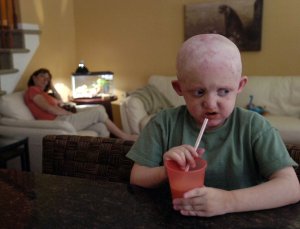'He just wants to be a kid'
 By DANIELLE LYNCH By DANIELLE LYNCH
Shelly Marone said she knew something was wrong with her son as soon as he was born. But the problem was that there wasn’t enough known about her son’s condition.
Inside her home in Thornbury, Delaware County, Marone talked about her son. The window shades are closed and the lights are either off or dimmed because her son cannot be under light for too long.
Jayden, now 5, was diagnosed with Hay Wells Syndrome, a rare form of ectodermal dysplasia, which caused him to look burned and lose parts of his skin. Hay Wells Syndrome, also known as ankyloblepharon-ectodermal dysplasia-clefting (AEC), is one of 150 heritable ectodermal disorders that affect the outer layer of tissue in a developing baby, according to the National Foundation for Ectodermal Dysplasias. It can affect both males and females.
About seven of every 10,000 babies are born with an ED syndrome, according to this national organization based in Mascoutah, Ill. And the National Foundation for Ectodermal Dysplasias is in touch with 78 individuals who are affected specifically by the Hay Wells Syndrome worldwide, according to Jodi Edgar Reinhardt, spokeswoman for the organization.
Hay Wells Syndrome affects the ectoderm as well as structures that do not derive from the ectoderm, according to the NFED. Hair, nails, eyelashes, teeth and sweat glands are affected. The NFED states that two features set Hay Wells Syndrome apart from the other ectodermal dysplasias: associations of cleft lip and palate and fusion of the upper and lower eyelids.
As soon as Marone got home from the hospital, she knew she needed some help so she hired some nurses. She currently has 16 hours of nursing assistance every day.
Jayden now attends school at the Arc of Chester County because he has too many health issues, Marone said. She said she wanted to mainstream him but he has too many therapies.
“I don’t want to hold him back,” she said.
Although Jayden has trouble with fine motor skills such as writing or buttoning, he can do physical activities such as running and riding a bike. And his mother said he understands things well.
“He’s as smart as a whip,” Marone said. “He’s at the point where he can tell me what medicine he needs.”
But things have been tough. Jayden now has a feeding tube in his stomach, and he used to have a raw head and cleft palate, his mother said.
Marone said she’s seen progress. When her son was younger, the tiniest scrape would cause his skin to come off. But his skin is tougher now, she said. To help keep infections down, Marone said she alternates bleach and vinegar dilutions into her son’s bath water. And at least two times a day she and the nurses rub lotion on him.
As part of the symptoms of this diagnosis, Jayden does not sweat, have tears or salvia, Marone said. In addition, Jayden lacks hair and sometimes his fingernails and toenails become thin and peel off.
In addition to Jayden, Marone is a single mother of two other boys: 9-year-old Nicholas and 6-year-old Christian. At times, Marone said it’s tough to treat everyone equally because Jayden’s health issues put a strain on relationships.
“It’s not balanced and you have to accept that,” she said.
Marone said she’s so busy that she doesn’t have time to think about Jayden having the syndrome. She’s on the go from about 7 a.m. to 11 p.m. every day, taking care of him and her other boys.
“That’s how I make it – I don’t have time to think,” Marone said.
She said she’s also constantly looking for doctors for Jayden’s health problems.
“Every issue with him takes months,” Marone said. “It’s complex … you don’t just go to the family doctor.”
And this also puts a strain on Jayden.
“He’s tired of us telling him what to do – he just wants to be a kid,” said Denise Whiteman, a nurse with Home Health Specialists in Media.
Marone has found comfort and help from the nurses, the national foundation and from other parents she’s met at conferences.
Research specific to Hay Wells Syndrome is growing and the gene, p63, that causes it has been identified, said Edgar Reinhardt.
“In 2002, the NFED began to research the syndrome so we could understand it better and develop improved treatment protocols,” said Edgar Reinhardt. “Because of two symposia we held on the conditions in 2003 and 2006, we were able to develop a skin care protocol for patients with skin erosions.”
Marone is hopeful that her son will do well in life.
“I think he’ll do anything but he’ll have to learn how to do things,” she said.
For more information about Hay Wells Syndrome and ectodermal dysplasias, visit the National Foundation for Ectodermal Dysplasias at http://nfed.org/.
To contact staff writer Danielle Lynch, send an e-mail to dlynch@dailylocal.com. |
